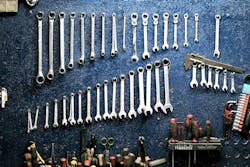Dan Garlock calls it his shop’s “umbrella.” From one end of the facility to the other, from the front office to the repair floor, then out into the parking, then even a half mile down the road, his technicians can access Silver Lake Auto and Tire’s Wi-Fi connection. At any point during the day, his employees can access the Internet connection when performing daily inspections.
It may seem over-the-top and unnecessary at first glance, but as Garlock has tweaked and perfected his three-shop operation’s digital inspection process over the years, this is just one adjustment in a long line of adjustments that formed an efficient, profitable procedure.
“If you’re only looking at the time it takes to perform digital inspections, you’re only looking surface deep,” Garlock says. There are a host of ways to capitalize on the technology you’ve take the time to research and invest in, and that’s what Garlock has done since purchasing his Wisconsin MSO’s digital inspection software in 2014. Since, his team has performed over 30,000 inspections, and each year they only become more and more profitable with the endeavor—all thanks to a detailed, stringent process.
Forecasting an ROI is one thing, but ensuring the ROI is another. So here are Garlock’s tips for working with your team to develop a process for new equipment.
Tip 1: Know Your Reasoning
There are many reasons to implement digital inspections—the prospect of going paperless, the benefit of sending photos to customers, the digital library you can build with electronic documents. But for Garlock, it all came down to one factor: the customer.
“The whole reason we do them is so we can build that trust with customers through pictures,” he says. “We want them informed to make buying decisions, and the best way to do that is with digital inspections.”
Thus, the goal with digital inspections was twofold: improve customer trust, improve ARO. With those kinds of goals in mind, Garlock says you can then start to form the initial processes around your technology. From the way service advisors speak to customers to the communication between techs and the front office, your reasoning for purchasing the software will shape how you approach each tweak to the process.
Tip 2: Have a Trial Period
While you can evaluate workflow and determine many macro-level changes to a process, you’ll ultimately need your frontline employees to actually use the equipment and offer feedback.
For example, when Garlock took the plunge and bought digital inspection software back when the technology wasn’t very popular, he knew it would be tough to sell to his staff as a regular process. That’s why he enlisted his most technologically savvy technician and service advisor to test the equipment first.
By enlisting the front and back end of the repair, Garlock’s employees were able to suss out the hiccups that could occur with customer communication and the unexpected efficiencies during the inspection. By meeting with those two employees regularly, Garlock was better able to determine an initial process. And because he had his top technician and service advisor’s approval, it created immediate buy-in with his team, as those employees could now be coached by their own team members.
Tip 3: Invest in Ancillary Technology
Sometimes a tool is just a tool—but more often than not, as Garlock can attest to, one tool cannot exist without other technologies backing it up. So as you build your new process, remember that it can only be as efficient as your environment and tool arsenal allows it to be.
Garlock is the first to admit that digital inspections are necessarily faster than regular pen-and-paper inspections. And at first, they were downright timesucks. But that wasn’t because his team hadn’t formed the right process—it’s because his shop’s touch pads and Internet weren’t up to par. So as Garlock invested in better equipment and stretched his shop’s Wi-Fi umbrella, the entire process naturally became more efficient.
For starters, he realized that purchasing more expensive touchpads netted a larger return, as the battery lasted the entire day as opposed to a few hours. Also, the latest touchpads will support the app his shop needs for inspections. At one time, his iPad Minis no longer supported the app, meaning he had to buy 12 new touchpads all at once.
The improved Wi-Fi connection allows his technicians to make notes while out performing test drives or checking something in the parking lot, and allows service advisors to go over any vehicle issues with customers in the parking lot. In the end, all of these subsequent investments have allowed the digital inspection process to grow and take new shapes.
Tip 4: Ask for Feedback
Once all the groundwork has been laid for your process, you’ll then want to tweak it accordingly. If you preach efficiency and productivity, then your team will know to watch out for anything that will improve those metrics.
Thus, meet with your team regularly and get any process changes down on paper. For Garlock’s shop, something as simple as moving some inspection items to different parts of the sheet made a huge difference. By doing that, technicians were able walk around the vehicle and check the vehicle in a specific order every time.
Garlock also got some valuable feedback from his service advisors. At first when they started with digital inspections, the technicians were recommending varying levels of work. For instance, Tech A would recommend transmission service, but then 3,000 miles later, Tech B would say the transmission was fine. This created distrust with the customer.
“That allows you to create standards,” Garlock says. “It’s not based on opinions, but data and fact. It’s a much easier message delivered to customer.”


